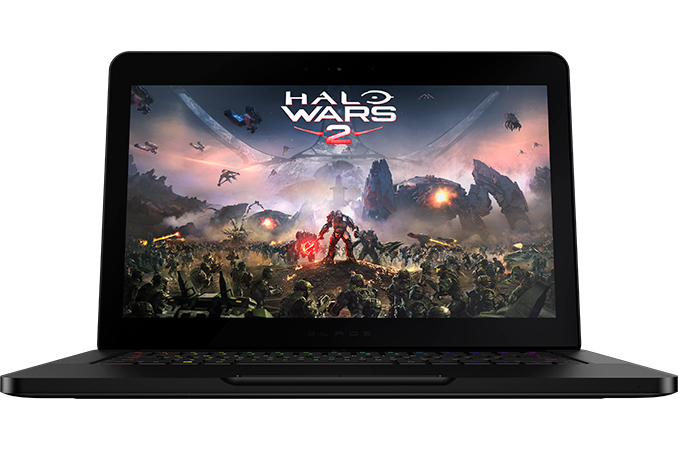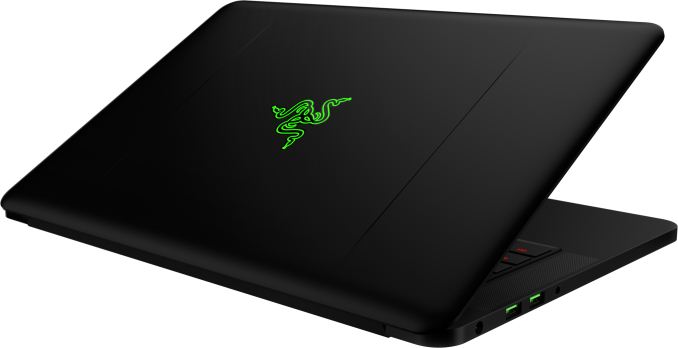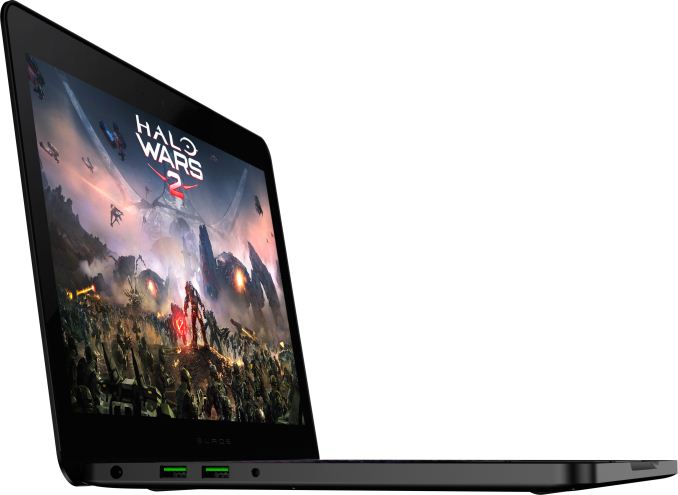Razer Blade Gets Core i7-7700HQ, Adds 4K Touchscreen, 1 TB SSD Options
by Anton Shilov on February 14, 2017 12:00 PM EST
Razer this week introduced an upgraded version of its latest Blade laptop that is now powered by Intel’s quad-core Kaby Lake processor along with DDR4-2400 memory and has 4K display and 1 TB SSD options. The 14” gaming notebook uses the same 17.8 mm-thick chassis introduced last year and has the same I/O capabilities, but some minor differences in weight. Meanwhile, it is important to note that the entry-level Razer Blade now costs $100 less than it used to last year, but at the expense of a lower-resolution display.
The new Razer Blade is based on the Intel Core i7-7700HQ (4C/8T, 2.8/3.8 GHz, 6 MB, 45 W) processor as well as the HM175 PCH (so, the same motherboard as before). The new chip is powered by the Kaby Lake microarchitecture, has higher frequencies compared to its predecessor that was used in last year’s Blades (Core i7-6700HQ) and supports Speed Shift v2 technology as well as other improvements. Along with the Kaby Lake CPU, the new Blade also got 16 GB of faster DDR4-2400 memory (soldered to the mainboard). In addition to 256 GB and 512 GB M.2 (NVMe/PCIe) SSDs, Razer now also offers a 1 TB PCIe drive as an option. When it comes to graphics, the new Blade uses NVIDIA’s GeForce GTX 1060 with 6 GB of GDDR5 memory and an HDMI 2.0b output, just like the predecessor introduced last fall.
Apart from the CPU and DRAM upgrades, Razer changed display options for the latest breed of Blade laptops. Last year the company only offered its Blades with touch-enabled IGZO LCDs featuring 3200×1800 resolution, and a matte 1920x1080 on the entry level. This year the higher-end Blade machines will feature touch-enabled UHD displays (3840×2160). Usage of the lower-resolution panel allowed Razer to reduce the price of the entry-level Blade to $1899 (or by $100), but at present we do not know how much the 4K SKUs is going to cost. In any case, systems featuring FHD panels will be slightly lighter and will have a longer battery life than models with UHD monitors. We haven't heard back from Razer on if the new UHD display continues to be a Sharp IGZO panel or not. Apart from displays, different Blade systems will look and feel exactly the same: both use a solid CNC-milled aluminum chassis with a matte black finish.
| Razer Blade Comparison | ||||||
| 2017 Razer Blade FHD | 2017 Razer Blade UHD | Late 2016 Razer Blade | ||||
| CPU | Intel Core i7-7700HQ 4C/8T 2.8 GHz/3.8 GHz 6 MB 45 W |
Intel Core i7-6700HQ 4C/8T 2.6/3.5 GHz 6 MB 47W |
||||
| GPU | NVIDIA GTX 1060 6 GB | |||||
| Memory | 16 GB DDR4-2400 | 16 GB DDR4-2133 | ||||
| Display | 1920×1080 matte | 3840×2160 touch | 3200×1800 IGZO touch | |||
| Storage | 256/512/1024 GB PCIe M.2 | 256/512 GB PCIe M.2 | ||||
| I/O | 3×USB 3.0 HDMI 2.0b Thunderbolt 3/USB-C |
|||||
| Wireless | Killer Wireless-AC 1535 | |||||
| Dimensions | 13.6" × 9.3 " × 0.70" 345 mm × 235 mm × 17.8 mm |
|||||
| Weight | 1.86 kg 4.1 lbs |
1.95 kg 4.3 lbs |
1.93 kg 4.25 lbs |
|||
| Battery | 70 Wh | |||||
| Keyboard | Razer Chroma anti-ghosting | |||||
| Price | $1899 | unknown | $1999-$2199 | |||
As for the rest I/O capabilities, they remained very similar to those of the last year’s Razer Blade models (because the chassis and the motherboard are the same as those used on the late 2016 Blade): Rivet Networks' Killer 1535 802.11 2×2 Wi-Fi + BT 4.1 controller, one Thunderbolt 3/USB 3.1 Type-C port, three USB 3.0 headers, an HDMI 2.0b output, a 2 MP webcam, built-in speakers and a microphone, a TRRS audio connector, a keyboard with RGB backlighting and so on. In a bid to appeal to those who care about security, there is a TPM 2.0 security chip installed.
The new Razer Blade notebooks with FHD screens are available now in North America and Europe starting from US$1,899/C$2,749/€2.149/£1.799. The laptops with 4K UHD panels will be available in Q2 and Razer does not have pricing available at the moment, but expect it to be similarly priced to the outgoing QHD+ model.
Related Reading:
Source: Razer


















47 Comments
View All Comments
BrokenCrayons - Tuesday, February 14, 2017 - link
I'm sure people out there are falling all over themselves to throw money at pushing lower-than-native resolutions on their 4K gaming laptop packing second-from-the-bottom-end GPU!Lonyo - Tuesday, February 14, 2017 - link
It's at least midrange, especially in historic pricing terms. And it would be third from bottom anyway, 1050 and 1050Ti.It's faster than the previous gen high end (980), extra so on the laptop front since the 980M was nowhere near a 980.
BrokenCrayons - Tuesday, February 14, 2017 - link
According to Anandtech around the time of the 980m's release, the claim was 75% performance when compared to the desktop version so I think "nowhere near" is a bit of an inflation for the sake of argument. Here's a source:http://www.anandtech.com/show/8585/nvidia-geforce-...
As for the 1050 (even the Ti variant) being faster than a 980m...no, it really isn't and here's some numbers for you to use to compare them:
980m
http://www.notebookcheck.net/NVIDIA-GeForce-GTX-98...
1050Ti
http://www.notebookcheck.net/NVIDIA-GeForce-GTX-10...
Any other thoughts?
ciparis - Wednesday, February 15, 2017 - link
I think he was pointing out the the 1060 (not the 1050) is faster than the 980.MamiyaOtaru - Thursday, February 16, 2017 - link
who taught you how to readBrokenCrayons - Thursday, February 16, 2017 - link
Likely the same people that taught you to use proper punctuation and capital letters.Flunk - Tuesday, February 14, 2017 - link
Depends what you want it for. I'd buy a laptop with a 4K screen to game at 1080p and use 4k for productivity. I fine half resolution quite usable for games on my 4K notebook.P.S. 1060 is top of the midrange, not low-end.
BrokenCrayons - Tuesday, February 14, 2017 - link
The 1070 is the top of the midrange of discrete GPUs. A 1060 is low end, one step up from NV's budget model 1050.lazarpandar - Tuesday, February 14, 2017 - link
That's a big step though.Additionally you're asserting yourself about something that simply isn't factual, and I'm not saying you're wrong per se, I just don't think these things are organized into high-mid-low-budget as concretely as you're implying that they are.
The fact that you seem to think the 1070 is mid-range holds no more weight than the fact that I think it's high-end, or the fact that Flunk thinks 1060 is mid-range. These things just aren't defined by an authority in that way.
BrokenCrayons - Tuesday, February 14, 2017 - link
That's precisely why I initially referred to it in its numeric stacking instead of assigning a performance range to it right away. I'm glad we can both agree that it's pretty silly to try to split hairs about where it is in performance rankings and that you can see my initial point clearly without putting up those same blinders to cover things up under a layer of intentional obfuscation.